The Greater Cairo Area
Cairo is often a starting point for many tours in Egypt such as Classical Tours, a holiday on the Red Sea or exploring the Western desert. Cairo is a vibrant cosmopolitan city which is a terrific place for a short stay if you want to combine some history, culture, entertainment and shopping.Cairo
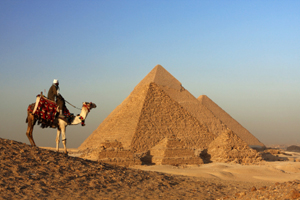 Cairo is the greatest city in the Islamic world. With 20 million inhabitants it is a colourful, vibrant, cosmopolitan and culturally rich place that one can either love or hate for its noise, smells, crowds, chaotic traffic and street life. Nevertheless, Cairo offers unique things to see. You can explore pharaonic monuments such as the Great Pyramids of Giza, the Sphinx, or the extraordinary Museum of Egyptian Antiquities. Besides the Mohamed Ali Mosque, the Citadel also hosts several museums. Islamic Cairo hosts the famous Khan Al-Khalili Bazaar and many impressive mosques such as Al-Azhar, Ibn Tulun, Saiyidna Hussein, while there are many narrow streets and a range of interesting architecture. Old Cairo is the place to explore Coptic monuments such as the Hanging Church, St. George’s Monastery and Coptic Museum. There are also a few interesting landmarks of modern Cairo like Cairo Tower, the Opera House and Al-Azhar park. Cairo is full of great places for dining, entertainment and shopping.
Cairo is the greatest city in the Islamic world. With 20 million inhabitants it is a colourful, vibrant, cosmopolitan and culturally rich place that one can either love or hate for its noise, smells, crowds, chaotic traffic and street life. Nevertheless, Cairo offers unique things to see. You can explore pharaonic monuments such as the Great Pyramids of Giza, the Sphinx, or the extraordinary Museum of Egyptian Antiquities. Besides the Mohamed Ali Mosque, the Citadel also hosts several museums. Islamic Cairo hosts the famous Khan Al-Khalili Bazaar and many impressive mosques such as Al-Azhar, Ibn Tulun, Saiyidna Hussein, while there are many narrow streets and a range of interesting architecture. Old Cairo is the place to explore Coptic monuments such as the Hanging Church, St. George’s Monastery and Coptic Museum. There are also a few interesting landmarks of modern Cairo like Cairo Tower, the Opera House and Al-Azhar park. Cairo is full of great places for dining, entertainment and shopping.Memphis
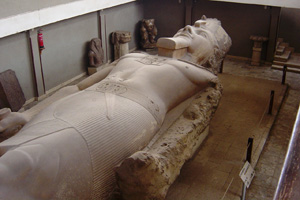 Memphis was an ancient capital of Egypt but today there are few remains of its days of glory. There is an open museum with a limestone Colossus of Ramses II and a giant alabaster sphinx.
Memphis was an ancient capital of Egypt but today there are few remains of its days of glory. There is an open museum with a limestone Colossus of Ramses II and a giant alabaster sphinx. Sakkara
Dahshur
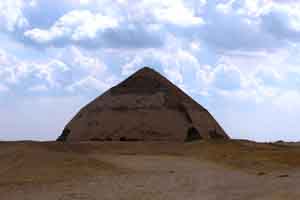 Dahshur is actually a field of pyramids, some of which are the most impressive and very significant in the history of pyramid building. The Red Pyramid is named after the colour of the limestone it was built from. The Bent Pyramid is possibly the most mysterious of all because it changes angle towards the top.
Dahshur is actually a field of pyramids, some of which are the most impressive and very significant in the history of pyramid building. The Red Pyramid is named after the colour of the limestone it was built from. The Bent Pyramid is possibly the most mysterious of all because it changes angle towards the top.Nile Valley (Upper Egypt)
Before the start of mass tourism in Red Sea resorts, cruising on the Nile between Luxor and Aswan was the most popular tourist activity in Egypt. Even today, Nile Cruises are the best choice for those interested in Ancient Egyptian civilisation and for those who enjoy a relaxing holiday and magnificent scenery cruising up or down the Nile. For those who love river voyages but have already been on the classical tour, the Lake Nasser Cruise is worth contemplating as it offers some breath-taking scenery and serenity because the area is largely unpopulated and is much less crowded with boats.Luxor
 Luxor, then known as Thebe, was the ancient capital of Egypt between 2100 to 750 B.C., during the peak time of pharaonic civilisation. With recent reconstruction and renovation, Luxor is developing into the greatest outdoor museum in the world. It is believed that it contains nearly one-third of the world’s antiquities. The most famous landmarks on the East Bank of the Nile include the Karnak Temple complex, Luxor Temple, Luxor Museum and Mummification Museum. On the West Bank there are well-preserved tombs revealing the ancient Egyptian concept of eternal life in the Valley of the Kings, Valley of the Queens and Valley of the Nobles. Also here are the Hatchepsut Temple, Ramesseum, Medinet Habu Temple and Collosi of Memnon.
Luxor, then known as Thebe, was the ancient capital of Egypt between 2100 to 750 B.C., during the peak time of pharaonic civilisation. With recent reconstruction and renovation, Luxor is developing into the greatest outdoor museum in the world. It is believed that it contains nearly one-third of the world’s antiquities. The most famous landmarks on the East Bank of the Nile include the Karnak Temple complex, Luxor Temple, Luxor Museum and Mummification Museum. On the West Bank there are well-preserved tombs revealing the ancient Egyptian concept of eternal life in the Valley of the Kings, Valley of the Queens and Valley of the Nobles. Also here are the Hatchepsut Temple, Ramesseum, Medinet Habu Temple and Collosi of Memnon.
Aswan
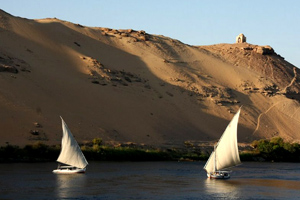 Aswan is the southernmost town in Egypt and many consider it to be the most beautiful winter resort for its fascinating scenery, warm weather and relaxed atmosphere, in strong contrast with the other main Egyptian towns. You can sail with a felucca (traditional sailboat) to the Kitchner’s Island botanical gardens or to Elephantine Island to explore the stone temples and Nilometer, or just sail on the Nile to observe nature. You can take a motorboat through the natural reserve with its cataracts, rich vegetation and birdlife and stop at a Nubian village to have a glimpse of their way of life. In the town there is also a Nubian Museum which hosts an exhibition of Nubian land and life and was built to remember Nubia as it was before the High Dam was built. The greatest pharaonic monument is the Philae Temple dedicated to the goddess Isis. There is also a quarry with an unfinished obelisk that easily allows you to imagine how they were carved from rock. On the West Bank there is the impressive Agha Khan Mausoleum, the Monastery of St. Simeon and Tombs of the Nobles. Stopping off at the High Dam completed in 1971 gives you a chance to see Lake Nasser, the world’s largest water reservoir.
Aswan is the southernmost town in Egypt and many consider it to be the most beautiful winter resort for its fascinating scenery, warm weather and relaxed atmosphere, in strong contrast with the other main Egyptian towns. You can sail with a felucca (traditional sailboat) to the Kitchner’s Island botanical gardens or to Elephantine Island to explore the stone temples and Nilometer, or just sail on the Nile to observe nature. You can take a motorboat through the natural reserve with its cataracts, rich vegetation and birdlife and stop at a Nubian village to have a glimpse of their way of life. In the town there is also a Nubian Museum which hosts an exhibition of Nubian land and life and was built to remember Nubia as it was before the High Dam was built. The greatest pharaonic monument is the Philae Temple dedicated to the goddess Isis. There is also a quarry with an unfinished obelisk that easily allows you to imagine how they were carved from rock. On the West Bank there is the impressive Agha Khan Mausoleum, the Monastery of St. Simeon and Tombs of the Nobles. Stopping off at the High Dam completed in 1971 gives you a chance to see Lake Nasser, the world’s largest water reservoir.Abu Simbel
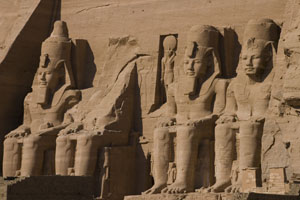 Abu Simbel is situated 280 km south of Aswan and is famous not only for its temples but also for the magnificent effort to preserve the temples when they were in danger of being ruined after the High Dam’s construction. The two temples in Abu Simbel were built by Ramses II, the first one is completely carved into rock and was built for himself and is dedicated to the Sun god Ra, while the second was built for his wife Nefertari and is dedicated to the goddess Hathor. In both temples there are well-preserved coloured carvings on the walls and ceilings, and twice a year (believed to be on the dates of the birth and coronation of Pharaoh Ramses II) sunrays illuminate the statues of Ptah, Amon, Ramses II and Ra in the innermost sanctuary chamber of the Ra temple.
Abu Simbel is situated 280 km south of Aswan and is famous not only for its temples but also for the magnificent effort to preserve the temples when they were in danger of being ruined after the High Dam’s construction. The two temples in Abu Simbel were built by Ramses II, the first one is completely carved into rock and was built for himself and is dedicated to the Sun god Ra, while the second was built for his wife Nefertari and is dedicated to the goddess Hathor. In both temples there are well-preserved coloured carvings on the walls and ceilings, and twice a year (believed to be on the dates of the birth and coronation of Pharaoh Ramses II) sunrays illuminate the statues of Ptah, Amon, Ramses II and Ra in the innermost sanctuary chamber of the Ra temple. Lake Nasser
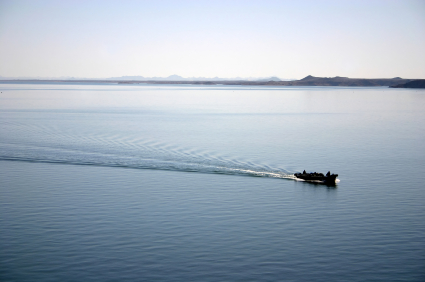 Lake Nasser is the most visible consequence of building the High Dam in Aswan and it stretches 500 km south from Aswan well into Sudan. In places it is more than 180 m deep and, with 6,000 square kilometres, it is the world’s largest water reservoir. On the banks and on islands there are remains of Nubian monuments which can be seen on a Lake Nasser Cruise: Kalabsha Temple, Wadi El Seboua, El Dakka and Mehraka Temples, Amada Temple, Temple of Derr, Qasr Ibrim, and the Tomb of Pennut.
Lake Nasser is the most visible consequence of building the High Dam in Aswan and it stretches 500 km south from Aswan well into Sudan. In places it is more than 180 m deep and, with 6,000 square kilometres, it is the world’s largest water reservoir. On the banks and on islands there are remains of Nubian monuments which can be seen on a Lake Nasser Cruise: Kalabsha Temple, Wadi El Seboua, El Dakka and Mehraka Temples, Amada Temple, Temple of Derr, Qasr Ibrim, and the Tomb of Pennut.
Edfu
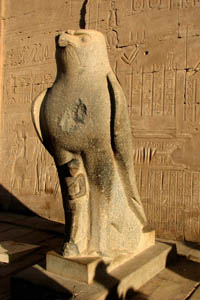 Edfu is about halfway between Luxor and Aswan and the settlement here dates back to the Ptolomeic period when a temple dedicated to the god Horus was erected. Horus is represented here as a falcon and the temple is one of the most beautiful temples and the second largest after the Karnak complex.
Edfu is about halfway between Luxor and Aswan and the settlement here dates back to the Ptolomeic period when a temple dedicated to the god Horus was erected. Horus is represented here as a falcon and the temple is one of the most beautiful temples and the second largest after the Karnak complex. Kom Ombo
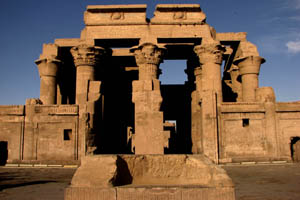 Kom Ombo is 45 km north of Aswan. The symmetrical temple dedicated to the two gods Sobek (the Crocodile god) and Haroeris (a form of Horus) is built on a hilltop overlooking the Nile and can be spotted from far away if you approach Kom Ombo by boat. On one wall there are carvings of surgical and medical instruments and procedures which explain much of ancient medicine. There is also a chamber with three mummified crocodiles. At sunset, it offers spectacular views as the stone temple changes colour as the sun disappears and then becomes lit when it gets dark.
Kom Ombo is 45 km north of Aswan. The symmetrical temple dedicated to the two gods Sobek (the Crocodile god) and Haroeris (a form of Horus) is built on a hilltop overlooking the Nile and can be spotted from far away if you approach Kom Ombo by boat. On one wall there are carvings of surgical and medical instruments and procedures which explain much of ancient medicine. There is also a chamber with three mummified crocodiles. At sunset, it offers spectacular views as the stone temple changes colour as the sun disappears and then becomes lit when it gets dark.
Dendara
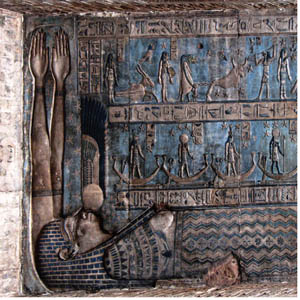 Dendara is a village about 60 km to the north of Luxor (on the West Bank of Qena). The Greco-Roman temple there is dedicated to the goddess Hathor and is especially known for the ceiling’s astronomic decoration with a symbolic representation of the sky.
Dendara is a village about 60 km to the north of Luxor (on the West Bank of Qena). The Greco-Roman temple there is dedicated to the goddess Hathor and is especially known for the ceiling’s astronomic decoration with a symbolic representation of the sky.Abydos
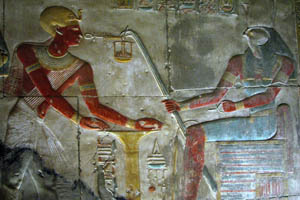 Abydos was the most important place of pilgrimage for Ancient Egyptians (it can be compared to Mecca for today’s Muslims), where the cult centre for the god Osiris was loacted. The Temple of Seti I there exhibits some of the finest artwork of Ancient Egypt with exquisite quality bas-reliefs.
Abydos was the most important place of pilgrimage for Ancient Egyptians (it can be compared to Mecca for today’s Muslims), where the cult centre for the god Osiris was loacted. The Temple of Seti I there exhibits some of the finest artwork of Ancient Egypt with exquisite quality bas-reliefs.The Red Sea and Eastern Desert
The mainland coast of the Red Sea offers some popular holiday destinations for relaxing on the beach and enjoying the underwater world. Snorkelling, diving, windsurfing & kiting, and golf are just a few of the activities tourists can enjoy. The close proximity of many interesting sites and Bedouin desert life allow a lot of opportunities for day excursions.Hurghada
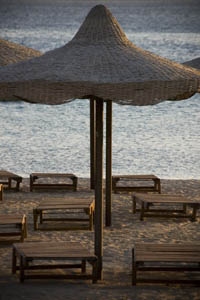 Hurghada has been transformed in the last 25 years from a small fishing village to a town with more than half a million residents who are mostly involved in the booming tourism industry. Hurghada is an ideal place for packaged tourism, it offers a great choice of hotels and entertainment and many nightlife spots. New resorts are being built along the coast towards Safaga in bays like Sahl Hasheesh, Makadi Bay and Soma Bay. There are many great places for water sport activities, along with two golf courses. The marine life is a little more distant from the shore than at Sharm El-Sheikh so tourists interested in snorkelling and diving have to take boat trips.
Hurghada has been transformed in the last 25 years from a small fishing village to a town with more than half a million residents who are mostly involved in the booming tourism industry. Hurghada is an ideal place for packaged tourism, it offers a great choice of hotels and entertainment and many nightlife spots. New resorts are being built along the coast towards Safaga in bays like Sahl Hasheesh, Makadi Bay and Soma Bay. There are many great places for water sport activities, along with two golf courses. The marine life is a little more distant from the shore than at Sharm El-Sheikh so tourists interested in snorkelling and diving have to take boat trips. El-Gouna
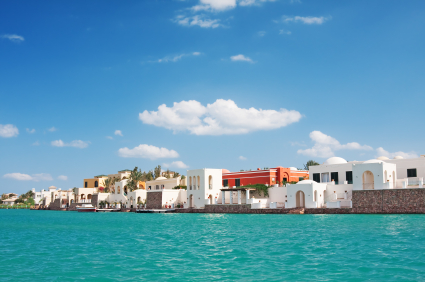 El-Gouna is a luxurious resort located 25 km north of Hurghada that is very popular with both the Egyptian jet set who own a lot of property there and Western tourists on package tours. It was built in the early 1990s on several islands linked by bridges and canals. Besides hotels, restaurants and entertainment places, there is a golf course inside the resort.
El-Gouna is a luxurious resort located 25 km north of Hurghada that is very popular with both the Egyptian jet set who own a lot of property there and Western tourists on package tours. It was built in the early 1990s on several islands linked by bridges and canals. Besides hotels, restaurants and entertainment places, there is a golf course inside the resort.Safaga
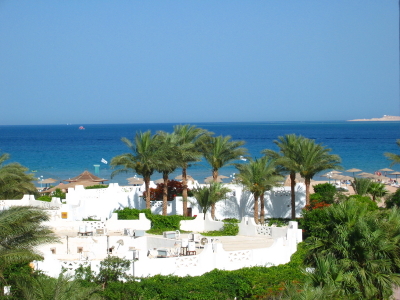 Safaga has less developed tourism facilities than its neighbouring Hurghada, although it is more famous for its healthy climate and spas which offer natural healing treatments for psoriasis, joint pains, and skin inflammation.
Safaga has less developed tourism facilities than its neighbouring Hurghada, although it is more famous for its healthy climate and spas which offer natural healing treatments for psoriasis, joint pains, and skin inflammation.Marsa Alam
 Marsa Alam has recently experienced a great tourism expansion and several luxurious tourist resort are being built (including the top-end resort of Port Ghalib which follows the similar concept of El-Gouna), and other infrastructure is developing. The town itself is quite bleak and there is not much to see or do there so most activities are within tourist resorts that stretch along almost 130 km of coast. It is worth mentioning that the Marsa Alam area is mostly windy, making it very pleasant in summer.
Marsa Alam has recently experienced a great tourism expansion and several luxurious tourist resort are being built (including the top-end resort of Port Ghalib which follows the similar concept of El-Gouna), and other infrastructure is developing. The town itself is quite bleak and there is not much to see or do there so most activities are within tourist resorts that stretch along almost 130 km of coast. It is worth mentioning that the Marsa Alam area is mostly windy, making it very pleasant in summer.The Monasteries of the Eastern Desert
The Monasteries of the Eastern Desert found a safe hiding place among the Red Sea Hills. The monasteries of St. Paul and St. Anthony are the oldest Egyptian monasteries that can be traced back to the beginning of Christian monasticism about 16 centuries ago. Due to seclusion many rituals have not changed much over time.
The Easter Desert Mountains
The Red Sea and Sinai
Sinai as a gateway between Africa and Asia has been a place of many historic events and battlegrounds in both distant and recent times. Although the place is rich with cultural heritage and natural beauty, it was only after it was returned by Israel to Egypt in the mid-1970s that tourism activity grew stronger. However, the tourism industry exploded with activity in the 1990s and especially around Sharm El-Sheikh it turned the desert into a vast stretch of hotels booming with life. Apart from beach holidays and water sports, Sinai also hosts several religious and historical places as well as good hiking opportunities in the mountain range. Even if you choose a beach holiday, there are a lot of day excursions available to explore Sinai.Sharm El-Sheikh
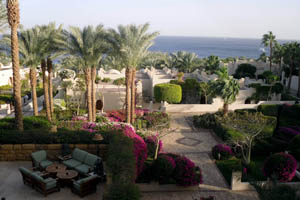 Sharm El-Sheikh is the most luxurious resort in Sinai, with its famous nightlife spot Naama Bay where one can find a wide range of restaurants, coffee shops, bars, discos and casinos. Of course, there are also many shops that sell both local and international products. The newly built Il-Mercato is another good place for shopping with boutiques and brand name stores. In the Old Market or Old Sharm, there are bazaars along with some good restaurants and an entertainment area built into rock. New developments are now stretching towards Nabq Bay, with another shopping and entertainment centre there called La Strada. Altogether, just about anything a tourist wishes to do is found in Sharm El-Sheikh. On top of what is offered inside the greater area of Sharm El-Sheikh, there are also many day excursions on offer.
Sharm El-Sheikh is the most luxurious resort in Sinai, with its famous nightlife spot Naama Bay where one can find a wide range of restaurants, coffee shops, bars, discos and casinos. Of course, there are also many shops that sell both local and international products. The newly built Il-Mercato is another good place for shopping with boutiques and brand name stores. In the Old Market or Old Sharm, there are bazaars along with some good restaurants and an entertainment area built into rock. New developments are now stretching towards Nabq Bay, with another shopping and entertainment centre there called La Strada. Altogether, just about anything a tourist wishes to do is found in Sharm El-Sheikh. On top of what is offered inside the greater area of Sharm El-Sheikh, there are also many day excursions on offer.Nabq Bay
The Ras Mohamed
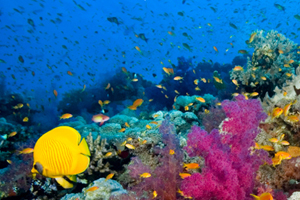 The Ras Mohamed peninsula is Egypt’s first marine natural park and is a protected area that mostly only allows day visitors (overnight camping is sometimes possible). Apart from probably the best coral reefs for either snorkelling or diving, there are lagoons for relaxing and swimming, mangrove trees and the wreck of the Dunraven divers can explore.
The Ras Mohamed peninsula is Egypt’s first marine natural park and is a protected area that mostly only allows day visitors (overnight camping is sometimes possible). Apart from probably the best coral reefs for either snorkelling or diving, there are lagoons for relaxing and swimming, mangrove trees and the wreck of the Dunraven divers can explore. Dahab
Nuweiba
Taba
 Taba is a town on the border with Israel, overlooking the Gulf of Aqaba. It has a few five-star resorts and other classes of accommodation and both the international airport and golf course have contributed to its development. Due to its proximity to Israel and Jordan it is also a great place for day trips to explore sites in those countries, although crossing the border may sometimes involve a lengthy process. Also close to Taba is Pharaoh’s Island with the Salah Al-Din fort.
Taba is a town on the border with Israel, overlooking the Gulf of Aqaba. It has a few five-star resorts and other classes of accommodation and both the international airport and golf course have contributed to its development. Due to its proximity to Israel and Jordan it is also a great place for day trips to explore sites in those countries, although crossing the border may sometimes involve a lengthy process. Also close to Taba is Pharaoh’s Island with the Salah Al-Din fort. St. Catherine
 St. Catherine is best known for the monastery which dates back to 337 A.D. when the Byzantine Empress Helena ordered that a chapel be built around the Burning Bush, which was a place of pilgrimage. The granite basilica was erected in the 6th century by Justinian. Today the place is run as a Greek Orthodox Monastery and can be visited any day except Fridays, Sundays and religious holidays. The town of St. Catherine is also a starting point for climbing Moses Mountain or starting a jeep safari or hiking with Bedouin guides.
St. Catherine is best known for the monastery which dates back to 337 A.D. when the Byzantine Empress Helena ordered that a chapel be built around the Burning Bush, which was a place of pilgrimage. The granite basilica was erected in the 6th century by Justinian. Today the place is run as a Greek Orthodox Monastery and can be visited any day except Fridays, Sundays and religious holidays. The town of St. Catherine is also a starting point for climbing Moses Mountain or starting a jeep safari or hiking with Bedouin guides.Moses Mountain
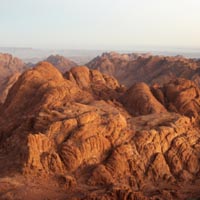 Moses Mountain or Mount Sinai is considered to be the mountain mentioned in the Bible where Moses received the Ten Commandments. It has evolved into a place of pilgrimage and many tourists climb the summit for the great views during sunrise above the Sinai mountains. There are two main paths to the mountain top, a camel track which is less demanding and a steep climb featuring rock-carved stairs.
Moses Mountain or Mount Sinai is considered to be the mountain mentioned in the Bible where Moses received the Ten Commandments. It has evolved into a place of pilgrimage and many tourists climb the summit for the great views during sunrise above the Sinai mountains. There are two main paths to the mountain top, a camel track which is less demanding and a steep climb featuring rock-carved stairs.The Sinai Desert & Mountains
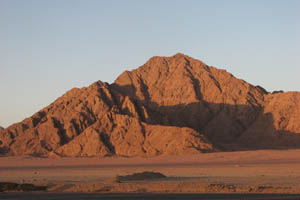 The Sinai Desert & Mountains offer a variety of colourful canyons (the best known are the Coloured Canyon and White Canyon), sand dunes, oases, high range mountains (including the highest peak Mount Catherine and Moses Mountain) and some historic monuments. As such, it is a great place to explore either by a jeep safari or hiking with Bedouin guides.
The Sinai Desert & Mountains offer a variety of colourful canyons (the best known are the Coloured Canyon and White Canyon), sand dunes, oases, high range mountains (including the highest peak Mount Catherine and Moses Mountain) and some historic monuments. As such, it is a great place to explore either by a jeep safari or hiking with Bedouin guides.El Thur
El Thur is the administrative capital of Sinai and there are many government building and apartment blocks for state employees. There are several interesting sites for tourists, including the Moses Bath and Raithu Monastery. It is a very popular windsurfing & kiteboarding spot because of its lagoon and good winds.
Ras Sudr
Ras Sudr is a strange combination of wonderful beaches and an oil refinery. The accommodation there caters mostly to local tourists. However, since windsurfers and kiteboarders have discovered the place some more tourist development is underway.
The North Sinai Coast
The North Sinai Coast is probably the least developed coastal area in Egypt. The best known resort town is El-Arish with its palmy white sandy beaches, but it remains marginally popular even with local tourists. It is much more traditional with regard to dress and alcohol consumption than places on the East Coast of Sinai.
The Western Desert
The Western Desert is a vast area of 681,000 square kilometres of land that stretches from the west of the Nile towards the Libyan border and is part of the Sahara desert across northern Africa. The desert itself is very versatile and there is colourful rocky terrain and big sand dunes so the place is perfect for desert safaris and hiking. There are several big oases in the desert which were once a source of exotic commodities and a place of great interest for potential invaders. Due to their remoteness, even today they have their own character and unique cultural patterns.The White Desert
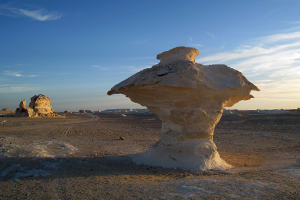 The White Desert is the area to the east of the road between Farafra and Bahariya. The natural park entrance is at the site of Chrystal Mountain, a ridge composed of quartz crystals. From there it is easy to approach Agabat, a natural temple of soft sand surrounded by rock blocks. Real white desert scenery opens up in the area where wind erosion has shaped white chalk monoliths into surreal forms. Because of its unique scenery the White Desert is a popular place for jeep safaris or hiking.
The White Desert is the area to the east of the road between Farafra and Bahariya. The natural park entrance is at the site of Chrystal Mountain, a ridge composed of quartz crystals. From there it is easy to approach Agabat, a natural temple of soft sand surrounded by rock blocks. Real white desert scenery opens up in the area where wind erosion has shaped white chalk monoliths into surreal forms. Because of its unique scenery the White Desert is a popular place for jeep safaris or hiking.The Black Desert
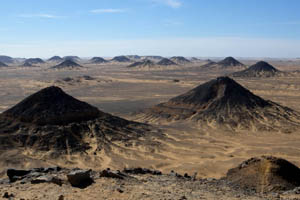 The Black Desert is the area southwest of Bahariya which is marked by volcano-shaped mountains and a big quantity of black stones covering the brown-orange floor. Climbing one of the mountains offers a splendid view of the desert.
The Black Desert is the area southwest of Bahariya which is marked by volcano-shaped mountains and a big quantity of black stones covering the brown-orange floor. Climbing one of the mountains offers a splendid view of the desert.The Great Sand Sea
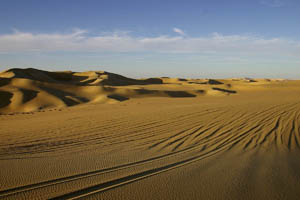 The Great Sand Sea is a vast area between Siwa Oasis and Gilf El-Kebir encompassing 72,000 square kilometres of sand dunes.
The Great Sand Sea is a vast area between Siwa Oasis and Gilf El-Kebir encompassing 72,000 square kilometres of sand dunes. Gilf El Kebir
Gilf El Kebir is a huge limestone and sandstone plateau which rises about 1000 m above the desert floor. It lies at the bottom southwest corner of Egypt, bordering Libya and Sudan. NASA has been studying the terrain as it is believed to have the closest resemblance to the surface of Mars with wadis having drained into lakes thousands of years ago and with huge dunes and the impressive mountain massif Jebel Uwaynat. At Wadi Sura there are examples of prehistoric rock art. The place became famous with the book and film The English Patient. Approaching the area is very difficult and only possible with jeep safaris.
Wadi Natrun
Wadi Natrun is the most northern part of the desert and is accessible just off the Cairo-Alexandria road. The name stems from natron salt deposits and several salt lakes can be found in the area. But the most visited sites are the ancient monasteries which date back to the beginnings of Christian monasticism: Deir al-Suryani, Deir Anba Bishoi and Deir Abu Maqar.
Oases:
Siwa
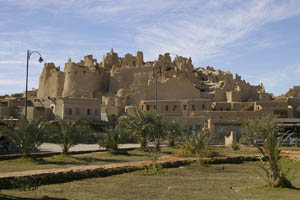 Siwa is the most unique of all oases, it is the most secluded in its position close to Libyan border and has managed to preserve its own culture and tradition over many centuries since it remained virtually independent from Egypt until the late 19th century. There are many lakes and springs in the area and the vegetation is rich with forests of palm trees and olive tree gardens. The most interesting archaeological sites are the Temple of Oracle visited by Alexander the Great, Amon Temple and tombs on the Mountain of the Dead. Shali is the remains of the citadel of the old town. There is a heritage museum Siwan House where the unique culture of Siwa is described and artefacts are exhibited. Siwa is also known as a place for the natural healing of rheumatoid problems.
Siwa is the most unique of all oases, it is the most secluded in its position close to Libyan border and has managed to preserve its own culture and tradition over many centuries since it remained virtually independent from Egypt until the late 19th century. There are many lakes and springs in the area and the vegetation is rich with forests of palm trees and olive tree gardens. The most interesting archaeological sites are the Temple of Oracle visited by Alexander the Great, Amon Temple and tombs on the Mountain of the Dead. Shali is the remains of the citadel of the old town. There is a heritage museum Siwan House where the unique culture of Siwa is described and artefacts are exhibited. Siwa is also known as a place for the natural healing of rheumatoid problems. Bahariya
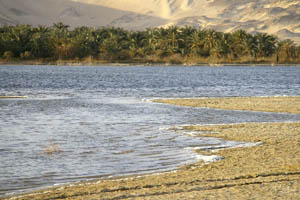 Bahariya is the smallest of the four depressions and is located 365 km southwest of Cairo. It is rich with springs of hot and cold water and they are known to have therapeutic effects due to their high levels of sulphurous and minerals. The main town is Bawiti which is home to some interesting archaeological sites with tombs, remains of temples and of course the exhibition of Golden Mummies which were discovered in a nearby valley.
Bahariya is the smallest of the four depressions and is located 365 km southwest of Cairo. It is rich with springs of hot and cold water and they are known to have therapeutic effects due to their high levels of sulphurous and minerals. The main town is Bawiti which is home to some interesting archaeological sites with tombs, remains of temples and of course the exhibition of Golden Mummies which were discovered in a nearby valley. Farafra
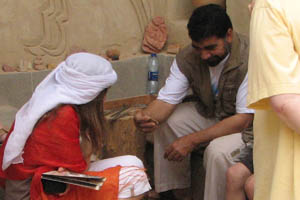 Farafra is the smallest oasis and besides being a starting point for exploring the White Desert there is not much to see in the town. There is a big spring of hot water known as Bir 6 and Badr, a local artist, runs a craft shop in his house featuring the interesting use of natural materials for painting and sculpturing.
Farafra is the smallest oasis and besides being a starting point for exploring the White Desert there is not much to see in the town. There is a big spring of hot water known as Bir 6 and Badr, a local artist, runs a craft shop in his house featuring the interesting use of natural materials for painting and sculpturing.Dakhla
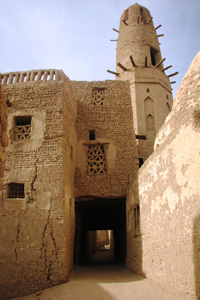 Dakhla welcomes visitors with its wonderful blend of colours (red hills, yellow sand and green fields). The main town is Mut and there are some other villages in the oasis. The most interesting site around Dakhla is the old Islamic town of Al-Qasr (built on Roman ruins) which features a mosque, a labyrinth of narrow streets with well-preserved buildings and several examples of crafts and arts. There are also several sites with tombs, temples and springs.
Dakhla welcomes visitors with its wonderful blend of colours (red hills, yellow sand and green fields). The main town is Mut and there are some other villages in the oasis. The most interesting site around Dakhla is the old Islamic town of Al-Qasr (built on Roman ruins) which features a mosque, a labyrinth of narrow streets with well-preserved buildings and several examples of crafts and arts. There are also several sites with tombs, temples and springs. Kharga
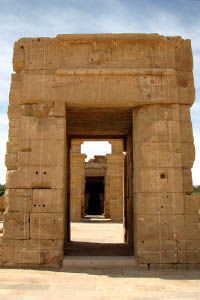 The Kharga oasis is the closest to Luxor and its capital El-Kharga is also the administrative capital of the New Valley Governorate (comprising Kharga, Dakhla and Farafra). In the town there is a museum with a wide selection of artefacts from pharaonic and Greco-Roman times. Around El-Karga there are several interesting archaeological sites (the temple of Hibis and the Bagawat Necropolis) while on the way to Luxor there are several more temples (Qasr El-Ghewita, Qasr Al-Zayan, temple of Dush).
The Kharga oasis is the closest to Luxor and its capital El-Kharga is also the administrative capital of the New Valley Governorate (comprising Kharga, Dakhla and Farafra). In the town there is a museum with a wide selection of artefacts from pharaonic and Greco-Roman times. Around El-Karga there are several interesting archaeological sites (the temple of Hibis and the Bagawat Necropolis) while on the way to Luxor there are several more temples (Qasr El-Ghewita, Qasr Al-Zayan, temple of Dush).Fayoum
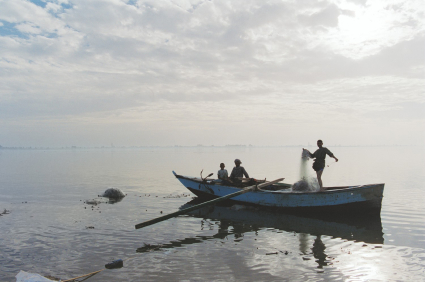 Fayoum is situated in a depression about 100 km south of Cairo and it gets its water supply from the Nile through Bahr Youssef. The oasis is a blend of desert and agriculture, the lakes (the largest of which is Qarun) are good spots for fishing and birdwatching. There are also several archaeological sites, including pyramids (the largest is the Hawara Pyramid), a few temples, an obelisk, waterwheels, monasteries and mosques. Wadi Rayan is a protected area known for its beautiful scenery, waterfalls, birds and unique fossils in the Valley of the Whales.
Fayoum is situated in a depression about 100 km south of Cairo and it gets its water supply from the Nile through Bahr Youssef. The oasis is a blend of desert and agriculture, the lakes (the largest of which is Qarun) are good spots for fishing and birdwatching. There are also several archaeological sites, including pyramids (the largest is the Hawara Pyramid), a few temples, an obelisk, waterwheels, monasteries and mosques. Wadi Rayan is a protected area known for its beautiful scenery, waterfalls, birds and unique fossils in the Valley of the Whales.Mediterranean Coast:
Alexandria
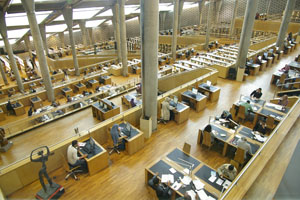 Alexandria is the second largest city (with a population of 3.5 million), the largest port in Egypt and a favourite summer resort for Cairo residents because of its long stretch of sandy beaches. The city was founded by Alexander the Great and for many centuries was the centre of cultural activity in the wider region. Apart from beaches, tourist attractions include: Pompey’s Pillar, the Roman Theatre, Kom al-Shuqafa Catacombs, the Montazah Palace, Qaitbay Citadel and Library of Alexandria.
Alexandria is the second largest city (with a population of 3.5 million), the largest port in Egypt and a favourite summer resort for Cairo residents because of its long stretch of sandy beaches. The city was founded by Alexander the Great and for many centuries was the centre of cultural activity in the wider region. Apart from beaches, tourist attractions include: Pompey’s Pillar, the Roman Theatre, Kom al-Shuqafa Catacombs, the Montazah Palace, Qaitbay Citadel and Library of Alexandria.El-Alamein
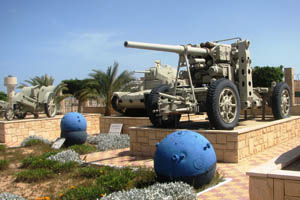 El-Alamein is the site of a famous WW II battle and there are several cemeteries and a museum where the battle is described and artefacts of all four armies are on display (British, Egyptian, German and Italian).
El-Alamein is the site of a famous WW II battle and there are several cemeteries and a museum where the battle is described and artefacts of all four armies are on display (British, Egyptian, German and Italian).Marsa Matrouh
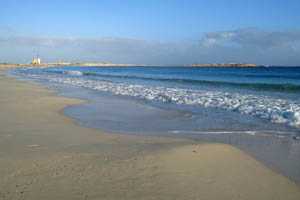 Marsa Matrouh is a small town 260 km west of Alexandria and is chiefly famous for its white sandy beach protected by a chain of natural rocky breakwaters extending into the sea parallel to the beach. There is also Rommel’s cave where the German general once strategised the WW II moves of his army.
Marsa Matrouh is a small town 260 km west of Alexandria and is chiefly famous for its white sandy beach protected by a chain of natural rocky breakwaters extending into the sea parallel to the beach. There is also Rommel’s cave where the German general once strategised the WW II moves of his army. The Nile Delta (Lower Egypt)
The Nile Delta is not well known amongst tourists because most of the old archaeological sites, except for the ruins of Tanis, Avaris and Bubastis, have disappeared over time. However, if you are interested in birdwatching, Lake Manzala is one of the country’s best spots. The Delta is predominantly agricultural and its towns are built to suit such needs and you can explore some typical delta architecture. The Delta is also known for Moulid festivals.Rosetta
Rosetta is a small town about 65 km east of Alexandria. The main interest here is Delta-style architecture dating from the Ottoman period from the 18th and 19th centuries when Rosetta was a port and at its peak status. Many of the mansions have been recently restored from the outside and you can also enter one of them to see the lifestyle of that period.
Tanta
Tanta is Egypt’s fifth largest city and most famous for the biggest Moulid Festival. In October, the Moulid of Saiyid Ahmed El-Badawi, the founder of one of the largest Sufi brotherhoods, marks the end of the cotton harvest and the whole city is flooded with chanting Sufis, musicians and even circus acts. These attract large numbers of vendors and spectators who come not only from the region and Egypt but also from other Arab countries.
Tanis, Avaris and Bubastis
Tanis, Avaris and Bubastis are the three best preserved archaeological sites in the Delta with pharaonic ruins of temples, cemeteries and Minoan-style frescoes.
Lake Manzala
Lake Manzala is a great birdwatching spot, especially in winter when you can watch herons, spoonbills and flamingos.
Middle Egypt (Lower Upper Egypt)
Middle Egypt (Lower Upper Egypt) stretches between Cairo and Qena and was not approached much by tourists in the 1990s for security reasons as the region was home to militant Muslim groups. Towns in the region are nowadays mostly visited as part of the Holy Family Escape religious tour.Minya
Minya is called the “Bride of Upper Egypt” and there are many elegant villas built by Italian architects for Greek and Egyptian cotton magnates. Around Minya there are several archaeological sites such as the Monastery of the Virgin, the Frazer tombs, the Church of Aba Hur and the Beni Hassan tombs.
Asyut
Asyut was the centre of the conflict between militants and the state in the 1980s and 1990s and even today there is a heavy presence of security forces. Near Asyut there are Dirunka with the present Convent of the Virgin and in El-Qusiya there is the Burnt Monastery and the Meir Tombs.
Sohag
Sohag is the third city along the Nile to the south and has a large Christian population. On Mondays it turns into a big animal market. But it is largely visited as a starting point for visiting the Red and White Monasteries which are in the vicinity.
The Suez Canal Area
The Suez Canal Area has been an important venue for maritime transports linking the Red Sea and the Mediterranean since its construction towards the end of the 19th century. With 167 km the canal is the third longest in the world and the longest without locks. Cities in the area can be visited on the way from Cairo to Sinai and especially if one wishes to observe ships moving along the canal. In spring it is also an interesting place for birdwatching as migrating vultures and eagles fly over the Suez.Port Said
Port Said was constructed when they started building the Suez Canal and became a major port by the end of 19th century. The port is still the main activity in the town with its half a million people. It has some reasonably good beaches and 12 km to the west is the Al-Gameel natural reserve that is famous for fishing.
Ismailia
Ismailia is called the city of gardens and flowers and is located midway between Port Said and the Suez. It was mostly built for foreign workers of the Suez Canal Company. There are nice beaches along Lake Timash.

